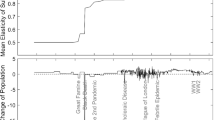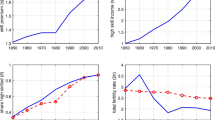Abstract
This article analyzes the interaction between growth and fertility via income distribution in a model in which fertility decisions are motivated by old-age support. It provides an explanation of the demographic transition of an economy from a stage of increasing fertility and low growth to a stage of low fertility, high human capital investments, and high growth.
Similar content being viewed by others
References
Aghion, P., and P. Bolton. (1992). “Distribution and Growth in Models of Imperfect Capital Markets.” European Economic Review 36, 603-611.
Aghion, P., and P. Howitt. (1998). Endogenous Growth Theory. Cambridge: MIT Press.
Altonji, J. G., and T. A. Dunn. (1996). “The Effects of Family Characteristics on the Return to Education.” Review of Economics and Statistics, 692-704.
Azariadis, C., and A. Drazen. (1990). “Demographic Transitions in a Dual Economy.” Mimeo.
Barro, R. J., and X. Sala-i-Martin. (1995). Economic Growth. New York: McGraw-Hill.
Becker, G. S., and R. J. Barro. (1988). “A Reformulation of the Economic Theory of Fertility.” Quarterly Journal of Economics 103, 1-25.
Becker, G. S., and R. J. Barro. (1989). “Fertility Choice in a Model of Economic Growth.” Econometrica 57, 481-501.
Becker, G. S., and G. Lewis. (1973). “On the Interaction Between the Quantity and Quality of Children.” Journal of Political Economy 81, 279-288.
Becker, G. S., K. Murphy, and R. Tamura. (1990). “Human Capital, Fertility, and Economic Growth.” Journal of Political Economy 98, S12-S37.
Cain, M. (1981). “Risk and Insurance: Perspectives on Fertility and Agrarian Change in India and Bangladesh.” Population and Development Review 7, 435-474.
Cain, M. (1983). “Fertility as an Adjustment to Risk.” Population and Development Review 9, 688-702.
Cain, M. (1985). “On the Relationship Between Landholding and Fertility.” Population Studies 39, 5-15.
Caldwell, J. C. (1982). Theory of Fertility Decline. New York: Academic Press.
Clay, D. C., and J. E. Vander Haar. (1993). “Intergenerational Support in the Third World.” Population Studies 47, 67-83.
Dahan, M., and D. Tsiddon. (1998). “Demographic Transition, Income Distribution, and Economic Growth.” Journal of Economic Growth 3, 29-52.
Dasgupta, P. (1993). An Inquiry into Well-Being and Destitution. Oxford: Oxford University Press.
David, P. A., and W. A. Sundstrom. (1984). “Bargains, Bequests, and Births.” Stanford Project on the History of Fertility Control Working Paper No. 12-R.
De Tray, D. (1983). “Children's Work Activities in Malaysia.” Population and Development Review 9, 437-455.
Dharmalingam, A. (1994). “Old Age Support: Expectations and Experiences in a South Indian Village.” Population Studies 48, 5-19.
Foster, A. D., and M. K. Rosenzweig. (1996). “Technical Change and Human-Capital Returns and Investments: Evidence from the Green Revolution.” American Economic Review 86, 931-953.
Galor, O., and D. Tsiddon. (1997). “The Distribution of Human Capital and Economic Growth.” Journal of Economic Growth 2, 93-124.
Galor, O., and D. Weil. (1998). “Population, Technology, and Growth: From the Malthusian Regime to the Demographic Transition.” Working Paper, Brown University.
Galor, O., and D. Weil. (1999). “From Malthusian Stagnation to Modern Growth.” American Economic Review 89, 150-154.
Galor, O., and J. Zeira. (1993). “Income Distribution and Macroeconomics.” Review of Economic Studies 60, 35-52.
Glomm, G., and B. Ravikumar. (1992). “PublicVersus Private Investment in Human Capital: Endogenous Growth and Income Inequality.” Journal of Political Economy 100, 818-834.
Goodfriend, M., and J. McDermott. (1995). “Early Development.” American Economic Review 85, 116-133.
Hanushek, E. A. (1986). “The Economics of Schooling: Production and Efficiency in the Public Schools.” Journal of Economic Literature 24, 1141-1177.
Hanushek, E. A. (1992). “The Trade-off between Child Quantity and Quality.” Journal of Political Economy 100, 84-117.
Jensen, E. R. (1990). “An Econometric Analysis of the Old-Age Security Motive for Childbearing.” International Economic Review 31, 953-968.
Kagitcibasi, C. (1982). “Old Age Security Value of Children; Cross-National Socioeconomic Evidence.” Journal of Cross-Cultural Psychology 13, 29-42.
Kremer, M. (1993). “Population Growth and Technological Change: One Million B.C. to 1990.” Quarterly Journal of Economics 108, 681-716.
Lucas, R. E. (1988). “On the Mechanics of Economic Development.” Journal of Monetary Economics 22, 3-42.
Murphy, K. M., A. Schleifer, and R. Vishny. (1989). “Income Distribution, Market Size, and Industrialization.” Quarterly Journal of Economics, 537-564.
Neher, P. A. (1971). “Peasants, Procreation, and Pensions.” American Economic Review 61, 380-389.
Newman, J. L. (1988). “A Stochastic Dynamic Model of Fertility.” Research in Population Dynamics 6, 41-68.
Nishimura, K., and J. Zhang. (1992). “Pay-as-You-Go Public Pensions with Endogenous Fertility.” Journal of Public Economics 48, 239-258.
Nugent, J. B. (1985). “The Old-Age Security Motive for Fertility.” Population and Development Review 11, 75-97.
Nugent, J. B., and T. Gillapsy. (1983). “Old-age Pension and Fertility in Rural Areas of Less Developed Countries: Some Evidence from Mexico.” Economic Development and Cultural Change 31, 809-829.
Perotti, R. (1993). “Political Equilibrium, Income Distribution, and Growth.” Review of Economic Studies 60, 755-776.
Persson, T., and G. Tabellini. (1994). “Is Inequality Harmful for Growth?” American Economic Review 84, 600-621.
Romer, P. M. (1986). “Increasing Returns and Long-Run Growth.” Journal of Political Economy 94, 1002-1037.
Rosenzweig, M. K. (1990). “Population Growth and Human Capital Investments: Theory and Evidence.” Journal of Political Economy 98, 38-70.
Sah, R. K. (1991). “The Effects of Child Mortality Changes on Fertility Choices and Parental Welfare.” Journal of Political Economy 99, 582-606.
Schultz, T. W. (1975). “The Value of the Ability to Deal with Disequilibria.” Journal of Economic Literature 13, 827-846.
Willis, R. J. (1980). “The Old Age Security Hypothesis and Population Growth.” In T. Burch, ed., Demographic Behavior: Interdisciplinary Perspectives on Decision Making (pp. 43-69). Boulder, CO: Westview Press.
Wolpin, K. I. (1984). “An Estimable Dynamic Stochastic Model of Fertility and Child Mortality.” Journal of Political Economy 92, 852-874.
Author information
Authors and Affiliations
Rights and permissions
About this article
Cite this article
Morand, O.F. Endogenous Fertility, Income Distribution, and Growth. Journal of Economic Growth 4, 331–349 (1999). https://doi.org/10.1023/A:1009884804855
Issue Date:
DOI: https://doi.org/10.1023/A:1009884804855




